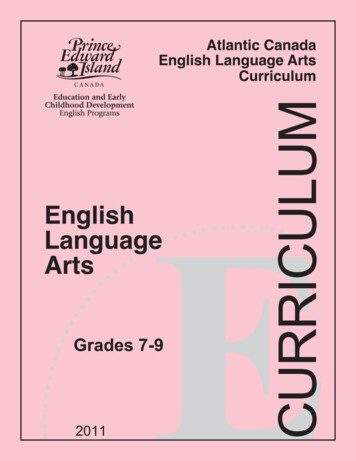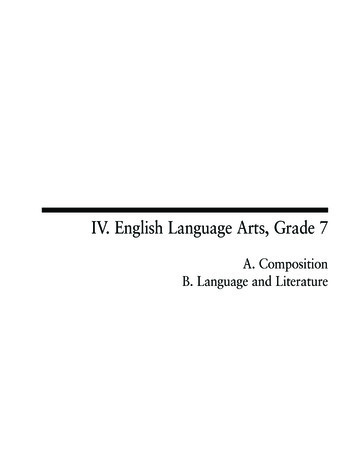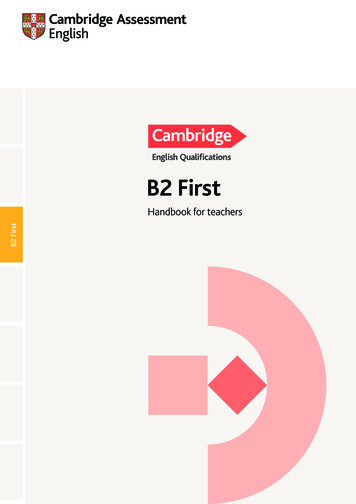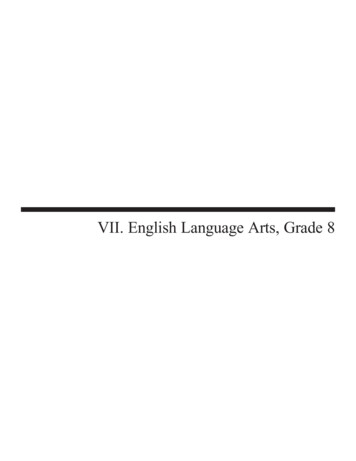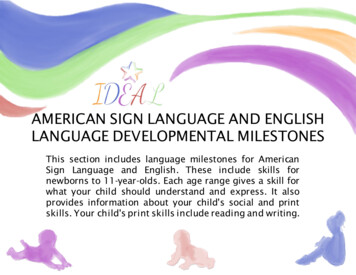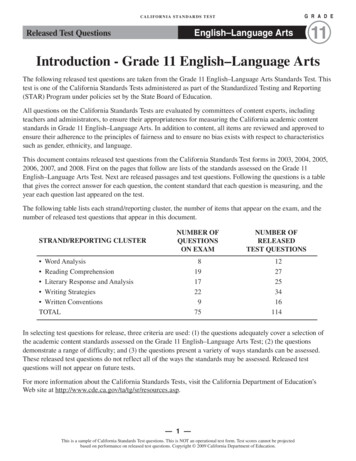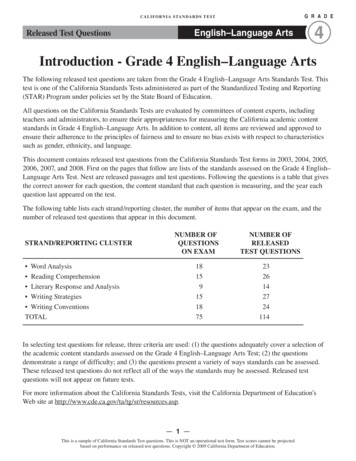
Transcription
G R A D ECA L I F O R N I A S TA N DA R D S T E S TEnglish–Language ArtsReleased Test Questions4Introduction - Grade 4 English–Language ArtsThe following released test questions are taken from the Grade 4 English–Language Arts Standards Test. Thistest is one of the California Standards Tests administered as part of the Standardized Testing and Reporting(STAR) Program under policies set by the State Board of Education.All questions on the California Standards Tests are evaluated by committees of content experts, includingteachers and administrators, to ensure their appropriateness for measuring the California academic contentstandards in Grade 4 English–Language Arts. In addition to content, all items are reviewed and approved toensure their adherence to the principles of fairness and to ensure no bias exists with respect to characteristicssuch as gender, ethnicity, and language.This document contains released test questions from the California Standards Test forms in 2003, 2004, 2005,2006, 2007, and 2008. First on the pages that follow are lists of the standards assessed on the Grade 4 English–Language Arts Test. Next are released passages and test questions. Following the questions is a table that givesthe correct answer for each question, the content standard that each question is measuring, and the year eachquestion last appeared on the test.The following table lists each strand/reporting cluster, the number of items that appear on the exam, and thenumber of released test questions that appear in this document.STRAND/REPORTING CLUSTERNUMBER OFQUESTIONSON EXAM Word Analysis Reading Comprehension Literary Response and Analysis Writing Strategies Writing ConventionsTOTAL18159151875NUMBER OFRELEASEDTEST QUESTIONS2326142724114In selecting test questions for release, three criteria are used: (1) the questions adequately cover a selection ofthe academic content standards assessed on the Grade 4 English–Language Arts Test; (2) the questionsdemonstrate a range of difficulty; and (3) the questions present a variety of ways standards can be assessed.These released test questions do not reflect all of the ways the standards may be assessed. Released testquestions will not appear on future tests.For more information about the California Standards Tests, visit the California Department of Education’sWeb site at http://www.cde.ca.gov/ta/tg/sr/resources.asp.— 1 —This is a sample of California Standards Test questions. This is NOT an operational test form. Test scores cannot be projectedbased on performance on released test questions. Copyright 2009 California Department of Education.
G R A D ECA L I F O R N I A S TA N DA R D S T E S T4English–Language ArtsReleased Test QuestionsREADINGThe Reading portion of the Grade 4 California English–Language Arts Standards Test has three strands/reporting clusters: Word Analysis, Reading Comprehension, and Literary Response and Analysis. Each ofthese strands/clusters is described below.The Word Analysis Strand/ClusterThe following five California English–Language Arts content standards are included in the Word Analysisstrand/cluster and are represented in this booklet by 23 test questions for grade 4. These questions representonly some ways in which these standards may be assessed on the Grade 4 California English–Language ArtsStandards Test.4RW1.0WORD ANALYSIS, FLUENCY, AND SYSTEMATIC VOCABULARY DEVELOPMENT:Students understand the basic features of reading. They select letter patterns andknow how to translate them into spoken language by using phonics, syllabication,and word parts. They apply this knowledge to achieve fluent oral and silent reading.4RW1.2Vocabulary and Concept Development: Apply knowledge of word origins, derivations,synonyms, antonyms, and idioms to determine the meaning of words and phrases.4RW1.3Vocabulary and Concept Development: Use knowledge of root words to determine themeaning of unknown words within a passage.4RW1.4Vocabulary and Concept Development: Know common roots and affixes derived fromGreek and Latin and use this knowledge to analyze the meaning of complex words (e.g.,international).4RW1.5Vocabulary and Concept Development: Use a thesaurus to determine related words andconcepts.4RW1.6Vocabulary and Concept Development: Distinguish and interpret words with multiplemeanings.— 2 —This is a sample of California Standards Test questions. This is NOT an operational test form. Test scores cannot be projectedbased on performance on released test questions. Copyright 2009 California Department of Education.
CA L I F O R N I A S TA N DA R D S T E S TG R A D EEnglish–Language ArtsReleased Test QuestionsThe Reading Comprehension Strand/ClusterThe following six California English–Language Arts content standards are included in the ReadingComprehension strand/cluster and are represented in this booklet by 26 test questions for grade 4. Thesequestions represent only some ways in which these standards may be assessed on the Grade 4 CaliforniaEnglish–Language Arts Standards Test.4RC2.0READING COMPREHENSION: Students read and understand grade-level-appropriatematerial. They draw upon a variety of comprehension strategies as needed (e.g.,generating and responding to essential questions, making predictions, comparinginformation from several sources). The selections in Recommended Readings inLiterature, Kindergarten Through Grade Eight illustrate the quality and complexity ofthe materials to be read by students. In addition to their regular school reading,students read one-half million words annually, including a good representation ofgrade-level-appropriate narrative and expository text (e.g., classic and contemporaryliterature, magazines, newspapers, online information).4RC2.1Structural Features of Informational Materials: Identify structural patterns found ininformational text (e.g., compare and contrast, cause and effect, sequential orchronological order, proposition and support) to strengthen comprehension.4RC2.3Comprehension and Analysis of Grade-Level-Appropriate Text: Make and confirmpredictions about text by using prior knowledge and ideas presented in the text itself,including illustrations, titles, topic sentences, important words, and foreshadowing clues.4RC2.4Comprehension and Analysis of Grade-Level-Appropriate Text: Evaluate newinformation and hypotheses by testing them against known information and ideas.4RC2.5Comprehension and Analysis of Grade-Level-Appropriate Text: Compare and contrastinformation on the same topic after reading several passages or articles.4RC2.6Comprehension and Analysis of Grade-Level-Appropriate Text: Distinguish betweencause and effect and between fact and opinion in expository text.4RC2.7Comprehension and Analysis of Grade-Level-Appropriate Text: Follow multiple-stepinstructions in a basic technical manual (e.g., how to use computer commands or videogames).— 3 —This is a sample of California Standards Test questions. This is NOT an operational test form. Test scores cannot be projectedbased on performance on released test questions. Copyright 2009 California Department of Education.4
G R A D E4CA L I F O R N I A S TA N DA R D S T E S TEnglish–Language ArtsReleased Test QuestionsThe Literary Response and Analysis Strand/ClusterThe following five California English–Language Arts content standards are included in the Literary Responseand Analysis strand/cluster and are represented in this booklet by 14 test questions for grade 4. These questionsrepresent only some ways in which these standards may be assessed on the Grade 4 California English–Language Arts Standards Test.4RL3.0LITERARY RESPONSE AND ANALYSIS: Students read and respond to a wide varietyof significant works of children’s literature. They distinguish between the structuralfeatures of the text and the literary terms or elements (e.g., theme, plot, setting,characters). The selections in Recommended Readings in Literature, KindergartenThrough Grade Eight illustrate the quality and complexity of the materials to be readby students.4RL3.1Structural Features of Literature: Describe the structural differences of variousimaginative forms of literature, including fantasies, fables, myths, legends, and fairy tales.4RL3.2Narrative Analysis of Grade-Level-Appropriate Text: Identify the main events of the plot,their causes, and the influence of each event on future actions.4RL3.3Narrative Analysis of Grade-Level-Appropriate Text: Use knowledge of the situation andsetting and of a character’s traits and motivations to determine the causes for thatcharacter’s actions.4RL3.4Narrative Analysis of Grade-Level-Appropriate Text: Compare and contrast tales fromdifferent cultures by tracing the exploits of one character type and develop theories toaccount for similar tales in diverse cultures (e.g., trickster tales).4RL3.5Narrative Analysis of Grade-Level-Appropriate Text: Define figurative language (e.g.,simile, metaphor, hyperbole, personification) and identify its use in literary works.— 4 —This is a sample of California Standards Test questions. This is NOT an operational test form. Test scores cannot be projectedbased on performance on released test questions. Copyright 2009 California Department of Education.
CA L I F O R N I A S TA N DA R D S T E S TEnglish–Language ArtsReleased Test QuestionsG R A D E4WRITINGThe Writing portion of the Grade 4 California English–Language Arts Standards Test has two strands/reportingclusters: Writing Strategies and Written Conventions. Each of these strands/clusters is described below.The Writing Strategies Strand/ClusterThe following eight California English–Language Arts content standards are included in the Writing Strategiesstrand/cluster and are represented in this booklet by 27 test questions for grade 4. These questions representonly some ways in which these standards may be assessed on the Grade 4 California English–Language ArtsStandards Test.4WS1.0WRITING STRATEGIES: Students write clear, coherent sentences and paragraphsthat develop a central idea. Their writing shows they consider the audience andpurpose. Students progress through the stages of the writing process (e.g.,prewriting, drafting, revising, editing successive versions).4WS1.1Organization and Focus: Select a focus, an organizational structure, and a point of viewbased upon purpose, audience, length, and format requirements.4WS1.2Organization and Focus: Create multiple-paragraph compositions:2) Establish and support a central idea with a topic sentence at or near the beginning ofthe first paragraph.3) Include supporting paragraphs with simple facts, details, and explanations.4) Conclude with a paragraph that summarizes the points.4WS1.3Organization and Focus: Use traditional structures for conveying information (e.g.,chronological order, cause and effect, similarity and difference, and posing and answeringa question).4WS1.5Research and Technology: Quote or paraphrase information sources, citing themappropriately.4WS1.6Research and Technology: Locate information in reference texts by using organizationalfeatures (e.g., prefaces, appendixes).4WS1.7Research and Technology: Use various reference materials (e.g., dictionary, thesaurus,card catalog, encyclopedia, online information) as an aid to writing.4WS1.8Research and Technology: Understand the organization of almanacs, newspapers, andperiodicals and how to use those print materials.4WS1.10Evaluation and Revision: Edit and revise selected drafts to improve coherence andprogression by adding, deleting, consolidating, and rearranging text.— 5 —This is a sample of California Standards Test questions. This is NOT an operational test form. Test scores cannot be projectedbased on performance on released test questions. Copyright 2009 California Department of Education.
G R A D E4CA L I F O R N I A S TA N DA R D S T E S TEnglish–Language ArtsReleased Test QuestionsThe Written Conventions Strand/ClusterThe following seven California English–Language Arts content standards are included in the WrittenConventions strand/cluster and are represented in this booklet by 24 test questions for grade 4. Thesequestions represent only some ways in which these standards may be assessed on the Grade 4 CaliforniaEnglish–Language Arts Standards Test.4WC1.0WRITTEN AND ORAL ENGLISH LANGUAGE CONVENTIONS: Students write andspeak with a command of standard English conventions appropriate to this gradelevel.4WC1.1Sentence Structure: Use simple and compound sentences in writing and speaking.4WC1.2Sentence Structure: Combine short, related sentences with appositives, participialphrases, adjectives, adverbs, and prepositional phrases.4WC1.3Grammar: Identify and use regular and irregular verbs, adverbs, prepositions, andcoordinating conjunctions in writing and speaking.4WC1.4Punctuation: Use parentheses, commas in direct quotations, and apostrophes in thepossessive case of nouns and in contractions.4WC1.5Punctuation: Use underlining, quotations marks, or italics to identify titles of documents.4WC1.6Capitalization: Capitalize names of magazines, newspapers, works of art, musicalcompositions, organizations, and the first word in quotations when appropriate.4WC1.7Spelling: Spell correctly roots, inflections, suffixes and prefixes, and syllable constructions.— 6 —This is a sample of California Standards Test questions. This is NOT an operational test form. Test scores cannot be projectedbased on performance on released test questions. Copyright 2009 California Department of Education.
CA L I F O R N I A S TA N DA R D S T E S TG R A D EEnglish–Language ArtsReleased Test Questions4Read these two passages about changes. Think about how the passages are alike and how they are different.The Purest HeartA Story from China1In a forest in China, there lived a snake. The snake had a beautiful garden of flowers. One day the snakecaught Chow Wing gathering the snake’s flowers for his three daughters. The snake was angry. “Chow Wing,”he hissed, “you must give me one of your daughters as a wife.” Frightened, the man agreed.2At home, Chow Wing grew sick with worry. He could neither eat nor sleep.3“Please eat, Father,” said his eldest daughter, Hua.4“I am too worried,” he said. “Hua, will you marry the snake and save us?”5“You cannot ask me to marry a snake, Father!” said Hua, laughing. “He is so ugly, and I am beautiful.Everyone says so.”6Next he turned to Fung, his middle daughter. “Fung, will you marry the snake?”7“Dearest Father,” said Fung, sighing deeply. “This snake is so harsh. I cannot!”8The youngest daughter, Tao, stepped forward. “I will marry the snake,” she said.9In the forest some days later, sweet Tao married the snake. She became a good wife, cleaning and cookingand always being kind and respectful to her husband.10One scorching summer afternoon, Tao returned from collecting water to find the snake dying from thirst.Quickly she plunged him into the cool water that she had brought. Before her eyes, he began to grow andchange. When he had completed this change, he was a strong and handsome young man!11“Tao,” he said. “A spell changed me into an ugly snake, but your love and kindness changed me back intomy real self.”12The happy couple visited Chow Wing, Hua, and Fung. How amazed they were! The sisters also felt pangs ofenvy, now that Tao was married to such a fine young man. Deep in their hearts, though, they knew that she wasthe one of pure heart, the only one who could have broken the evil spell.— 7 —This is a sample of California Standards Test questions. This is NOT an operational test form. Test scores cannot be projectedbased on performance on released test questions. Copyright 2009 California Department of Education.
G R A D E4CA L I F O R N I A S TA N DA R D S T E S TEnglish–Language ArtsReleased Test QuestionsKapapitoe and the LizardA Story from Indonesia1In an Indonesian jungle lived an old woman who had raised a lizardas if he were her son. One day the lizard said, “Please go to the house ofseven sisters. Ask if one of the sisters will marry me.”2The old woman went to the seven single sisters’ house and asked theoldest to marry the lizard. The young woman laughed, saying, “Whowould marry a lizard?”3Each day for a week, the old woman returned with bridal gifts andthe marriage offer. One by one, six of the seven sisters refused. Finallyshe came to the youngest sister, Kapapitoe. “I will marry him,” she said.A week later, the old woman returned with the bridal gifts and the lizardin a basket.4The six older sisters were cruel to Kapapitoe’s lizard husband. After working in the jungle all day, they wouldclean their feet on his scaly back. As the planting feast of Ta Datoe approached, they said to him, “You may not goto this feast, for you are an ugly lizard.” Kapapitoe was kind to her husband and hated the way her sisters treatedhim. As the youngest, though, she had no power over them.5The day before the feast, the lizard asked his wife to carry him into the jungle. There he used his long, slashingtail to cut trees and grass until he had cleared a field for planting. “There, now they will surely let me go to theplanting feast tomorrow!” he said to Kapapitoe. Remaining cruel, the six sisters told him he was too revolting to beseen in their company.6On the day of the feast, Kapapitoe was ready to go to the river and wash. “Please take me to the river with you,”said her husband, and so she did. The lizard went into the water. When he came out, he was a handsome youngman dressed in fine clothes!7At the feast everyone asked, “Who is that handsome man with Kapapitoe?”8The old woman smiled and said, “It is her husband.”9Oh, how jealous those six sisters were! They tried time and time again to steal Kapapitoe’s husband from her,but he loved only his wife.CSR1P063— 8 —This is a sample of California Standards Test questions. This is NOT an operational test form. Test scores cannot be projectedbased on performance on released test questions. Copyright 2009 California Department of Education.
CA L I F O R N I A S TA N DA R D S T E S TEnglish–Language ArtsReleased Test Questions1 3 These passages are best described asAmodern-day science fiction stories.Bfables about animals who learn a lesson.Cmyths that explain how things began.Dfairy tales from two different countries. Read this sentence from “Kapapitoe and theLizard.”Remaining cruel, the six sisters told himhe was too revolting to be seen in theircompany.AThey would not give him any food to eat orwater to drink.BThey told Kapapitoe that she must leave theirhome with him.CThey cleaned their dirty feet by wiping themon his rough skin.DThey made him work hard all day, every day,in the jungle.CSR00222.0224 Which word is a synonym for revolting?AcheerfulBdisgustingCwonderfulDcruel4In “Kapapitoe and the Lizard,” how didKapapitoe’s six sisters show how much theydisliked and disrespected the lizard?CSR00215.0212G R A D EBoth the snake and the lizard change into menwhen theyAare in water.Bsee water.Cdrink water.Dsay “water.”CSR00213.021CSR10319.063— 9 —This is a sample of California Standards Test questions. This is NOT an operational test form. Test scores cannot be projectedbased on performance on released test questions. Copyright 2009 California Department of Education.
G R A D ECA L I F O R N I A S TA N DA R D S T E S T4English–Language ArtsReleased Test QuestionsRead these four passages about Kauai. Think about how the passages are alike and how they are different.Kauai IslandSAMPLE AKAUAI is the fourth largest island in Hawaii. Hawaii became the 50th state in 1959. Hawaii consists of eightmajor islands, in addition to more than a hundred smaller ones, and is located in the middle of the North PacificOcean. Kauai, located northwest of Oahu, is called the Garden Island. It was formed by volcanic activity andhas many mountains and canyons. Because of its dramatic beauty, it has been used as a setting for motionpictures such as South Pacific, King Kong, and Jurassic Park. Crops produced on Kauai include sugar cane,coffee, tropical fruits, and taro root, from which the Hawaiian dish poi is made. Kauai was an independent royalland until it became a part of the kingdom of Hawaii in 1810.SAMPLE BJune 25, 1999I had an amazing experience on the northern shore of Kauai today. We swamwith Pacific Green Sea Turtles. They are called honu in Hawaii and are a symbolof knowledge and long life. A special guide took us to the protective reefs wherethe turtles spend time. Under her guidance, we learned how to use thesnorkeling equipment that allowed us to be underwater and breathe air fromabove through a tube. But snorkeling wasn’t all she knew about! She was amarine biologist, so she knew all about the creatures of the ocean. She led ussafely through our adventure and told us many interesting things about whatwe saw. When I saw the first turtle, my heart was pounding. I was so excited! Wewere not allowed to touch them, but it was enough just to be near these gentleand graceful creatures. We swam among thousands of colorful fish, and we sawoctopuses and eels. What a special day!— 10 —This is a sample of California Standards Test questions. This is NOT an operational test form. Test scores cannot be projectedbased on performance on released test questions. Copyright 2009 California Department of Education.
CA L I F O R N I A S TA N DA R D S T E S TG R A D EEnglish–Language ArtsReleased Test Questions4SAMPLE CThe Unique Beauty of Hawaii’s Garden IslandKauai offers some of the most spectacular scenery in the world and many ways to enjoy it.Waimea Canyon is known as the Grand Canyon of the Pacific. You can view it from the lookout or explore itstropical wonders up close.Speaking of exploring, Koke’e State Park has over four thousand acres and 45 miles of trails. The amazingvariety of sights in this park even includes California redwood forests! Of course, this is in addition to anabundance of tropical flora and fauna.The NaPali Coast is one of the most amazing stretches of coastline on the planet. You have to see it to believe it!SAMPLE DHawaiian Shave IceA special treat enjoyed by children in the Hawaiian Islands on warm, sunny afternoons is shave ice flavored withdelicious fruit syrup.Shave ice comes in many tasty fruit flavors. Do you think you’ll have trouble choosing just one? Then select ourRainbow Shave Ice! You can taste many flavors at once. You might even want to try a Super Shave Ice, whichcomes complete with a scoop of creamy vanilla ice cream at the bottom!Come to Kalima’s on Kauaiand enjoy this refreshing tropical treat today!CSR1P037— 11 —This is a sample of California Standards Test questions. This is NOT an operational test form. Test scores cannot be projectedbased on performance on released test questions. Copyright 2009 California Department of Education.
G R A D E45 CA L I F O R N I A S TA N DA R D S T E S TEnglish–Language ArtsReleased Test Questions8 Read this sentence from Sample A.Crops produced on Kauai include sugarcane, coffee, tropical fruits, and taroroot, from which the Hawaiian dish poi ismade.In which sentence does the word dish have thesame meaning that it has in the sentence above?6 Which fact about Sample B helps you knowthat it is a journal entry instead of a letter?AIt has a date at the beginning.BIt doesn’t have a greeting or closing.CIt has only one paragraph.DIt doesn’t have pictures or illustrations.CSR01175.1709 You can tell from the title of Sample C that theauthor is probably going toAMountain climbing is not exactly my dish.BHer favorite dish is mashed potatoes withgarlic.Atell about a news event.Bdescribe a place.CConnor accidentally broke the dish he madein art class.Cpersuade you to buy something.DJasmine’s family has replaced its cabletelevision service with a dish.Dteach you how to make a craft.CSR01174.17010 CSR10302.037Read this part of a sentence from Sample B.Under her guidance, we learned how touse the snorkeling equipment . . .Information in all of the samples supports theidea thatAKauai has lovely state parks.Bswimming is a popular pastime on Kauai.CKauai is an enjoyable place to visit.Dmany crops are grown on Kauai.The root word in guidance means7 Ato be interested.Bto work quickly.Cto give direction.Dto try again.CSR01170.170CSR01173.170Which samples tell about things you might eatin Hawaii?ASamples A and BBSamples B and CCSamples A and DDSamples B and DCSR01176.170— 12 —This is a sample of California Standards Test questions. This is NOT an operational test form. Test scores cannot be projectedbased on performance on released test questions. Copyright 2009 California Department of Education.
CA L I F O R N I A S TA N DA R D S T E S TEnglish–Language ArtsReleased Test QuestionsG R A D E4Read these two tales about luck. Think about how the stories are alike and how they are different.A Tip o’ the HatA Tale from Ireland1Times were hard for Grady O’Hara’s family in Donegal,Ireland. For months they had lived on porridge alone. Oneday Maggie O’Hara said to her husband, “Grady, you mustfind work before we all starve.”2Grady traveled many miles, yet he found no work.Weary, he rested against a hill covered in soft green clover. Ashe dozed, Grady began to hear music. It seemed to be comingfrom within the hill. Parting the clover, Grady discovered acave opening just big enough to squeeze his body through.The wee cave was full of fairies. This was good, for in Irelandfairies must give a gift to a human who finds them.3The fairies offered Grady a fine iron pot. “Placed overfire,” said their leader, “it instantly fills with food. Go now,but tell no one of your luck.”4Grady headed home, but darkness soon fell. He came to a farmhouse and asked the owners if he couldstay there overnight. The Hanahans, who lived there, said he could stay, but a few potatoes were all they hadfor dinner. Well, Grady’s hunger was as fierce as a lion’s. He couldn’t help showing off his new pot. They allenjoyed a grand dinner, and Grady went to bed with a full stomach.5The next morning, Grady went home. He wanted to show his family the pot and to feed everyone a greatmeal. When he put the pot over the fire, though, nothing happened. Looking closely, Grady realized that itwas not the same pot! As he had slept soundly, the Hanahans had traded their pot for his.6Grady went to the fairies, and they agreed to trick the Hanahans. The fairies gave Grady an ugly green hatand sent him back to the farm. There, before going to bed, he boasted that the hat was very special. Sureenough, they took it from him.7As they tipped it over to look inside, several fairies jumped out and began playing ear-piercing music. TheHanahans held their hands over their ears.89“They won’t stop playing until you give me back my pot,” said Grady.Grady went home with his hat and his pot. He held a fantastic feast for his family and all the neighbors.None of them overstayed their welcome, though. They all had heard what happened when Grady tipped hishat!— 13 —This is a sample of California Standards Test questions. This is NOT an operational test form. Test scores cannot be projectedbased on performance on released test questions. Copyright 2009 California Department of Education.
G R A D E4CA L I F O R N I A S TA N DA R D S T E S TEnglish–Language ArtsReleased Test QuestionsThe Lucky CloakA Tale from Italy1Signor Luna and his son, Antonio, lived in a small town in Italy.One day, the old man decided that Antonio should go out into theworld and seek his fortune. Calling his son to him, he presenteda battered old cloak with one small pocket.2“How can this old cloak help me?” asked Antonio.3“You’ll see,” said his father. “Put it on and reach into thepocket.”4Antonio did so, and out came a silver coin. “A coin will appearwhenever you need one,” Signor Luna said, “but that is not all.Button the cloak now.”5When Antonio buttoned the cloak’s last button, he instantly became invisible! With the cloak and hisfather’s good wishes, the young man went on his way.6After walking what seemed like a very long distance, Antonio entered a small town with two cafés onthe cobblestone street. Antonio saw a pretty young woman in one of them, sitting alone.7“May I join you, Signorina?” he asked with a polite little bow.8“No,” she said, “for I can see by your tattered cloak that you are a poor man. I fear that you cannotafford to buy your meal.”9Antonio’s pride was injured. To repair the damage, he pulled out a coin and told the girl about thespecial pocket. Of course, she invited him to sit at her table.10With coins pulled from the cloak, Antonio bought a fine dinner for the young woman and himself. Afterthey had eaten, she began to complain of the cold. He took his cloak and placed it upon her shoulders.How puzzled he was when she held it tightly around herself and said, “Now this cloak belongs to me!”11Thinking quickly, Antonio said, “Wait! I’ll show you something even more wonderful about that cloak.You will be truly amazed.” With some hesitation, she removed the cloak and handed it back to Antonio.12“The best thing about this cloak is that when you button it—” Suddenly, Antonio was nowhere to beseen! He had disappeared. Unseen, he slipped away, glad to have regained the cloak and to have gainedsome valuable wisdom.CSR1P062— 14 —This is a sample of California Standards Test questions. This is NOT an operational test form. Test scores cannot be projectedbased on performance on released test questions. Copyright 2009 California Department of Education.
CA L I F O R N I A S TA N DA R D S T E S T13 Read this sentence from “A Tip o’ the Hat.”Parting the clover, Grady discovered acave opening just big enough to squeezehis body through.In which sentence does the word squeeze havethe same meaning that it has in the sentenceabove?AIf you get frightened, just squeeze my hand.BIn “A Tip o’ the Hat,” which of these reallycould have happened?AThe cave was full of fairies.BThe fairies agreed to trick the H
The following eight California English–Language Arts content standards are included in the Writing Strategies strand/cluster and are represented in this booklet by 27 test questions for grade 4. These questions represent only some ways in which these standards may be assessed on the Grade 4 Californ
